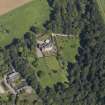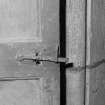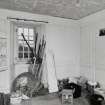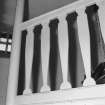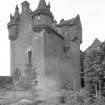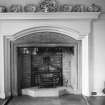Gardyne Castle
Tower House (Medieval)
Site Name Gardyne Castle
Classification Tower House (Medieval)
Alternative Name(s) Gardyne Castle Policies
Canmore ID 34658
Site Number NO54NE 7
NGR NO 57369 48790
Datum OSGB36 - NGR
Permalink http://canmore.org.uk/site/34658
- Council Angus
- Parish Kirkden
- Former Region Tayside
- Former District Angus
- Former County Angus
Gardyne Castle is a substantial laird's tower house with its origins in the 16th century. It is on the 65 metre contour line on the edge of a steep, wooded bank to the east. The Mains Farm lies to the west of the castle which is set within garden grounds. The castle is situated some 2 kms south of the A932 Forfar to Friockheim road and approximately 1 km to east of Middleton House.
Information from the Angus Recording Group of the Garden History Society in Scotland, 2015
NO54NE 7.00 57369 48790
(NO 5737 4879) Gardyne Castle (NR)
OS 6" map, (1971).
NO54SE 7.01 Centred NO 57403 48766 Garden
NO54SE 7.02 NO 5745 4880 Garden Gates
NO54SE 7.03 NO 57285 48819 West Gates
NO54NE 7.04 NO 57263 48768 Farmhouse (Mains of Gardyne)
NO54NE 7.05 NO 57249 48726 Steading (Mains of Gardyne)
NO54NE 7.06 NO 57273 48781 The Cottage (Mains of Gardyne)
NO54NE 7.07 NO 57327 48592 The Cottage
NO54NE 7.08 NO 57348 48543 Estate Bridge (Denton Burn)
NO54NE 7.09 NO 57354 48546 Estate Footbridge (Denton Burn)
NO54NE 7.10 NO 57189 48802 Lodge
NMRS NOTES:
Architect: H O Tarbolton 1914 Who's Who.
(Undated) information in NMRS.
The eastern block of Gardyne Castle is 16th century, with a round stair-tower surmounted by a square cap-house and a round turret on each angle of the E gable. There is a late 16th century heraldic panel in the S wall. The centre block of the mansion is 18th century and the NW part is modern.
Occupied and in good condition. Name confirmed (information from A Lyell, owner).
It was apparently owned by Gardyne of Leys before being acquired by the Lyells.
Visited by OS (JLD) 13 June 1958.
D MacGibbon and T Ross 1887-92.
No change.
Visited by OS (WDJ) 12 May 1966.
NO 5736 4879 We undertook outline analytical assessment of this complex building, part 16th-century fortified house, part 18th-century mansion, with later extensions, during February 2007. The eastern part of the building retains defensive features including gun ports and bartizans. The latter are notable for their unusual detailing, with false parapet and conical stone roofs surmounted by coronets. An ex situ date-stone of AD 1568 bearing the arms of James VI and the motto 'God Save The King', serves to strengthen the suggestion that the architecture of the building deliberately associates itself with both the new king and earlier Royal Stewart palace architecture (Holyrood, Falkland, Stirling) perhaps in emphatic reaction to the preceding Marian period. The Gardynes owed their rise to prominence as royal officials within the court of James VI.
Funder: Private client.
T Addyman 2007.
Gardyne Castle [NAT]
OS (GIS) MasterMap, July 2009.
Photographic Survey (20 April 1960)
Photographic survey of Gardyne Castle, Angus, by the Scottish National Buildings Record/Ministry of Works in April 1960.
Standing Building Recording (February 2007)
NO 5736 4879 We undertook outline analytical assessment of this complex building, part 16th-century fortified house, part 18th-century mansion, with later extensions, during February 2007. The eastern part of the building retains defensive features including gun ports and bartizans. The latter are notable for their unusual detailing, with false parapet and conical stone roofs surmounted by coronets. An ex situ date-stone of AD 1568 bearing the arms of James VI and the motto 'God Save The King', serves to strengthen the suggestion that the architecture of the building deliberately associates itself with both the new king and earlier Royal Stewart palace architecture (Holyrood, Falkland, Stirling) perhaps in emphatic reaction to the preceding Marian period. The Gardynes owed their rise to prominence as royal officials within the court of James VI.
Funder: Private client.
Thomas Addyman, 2007.





































































































